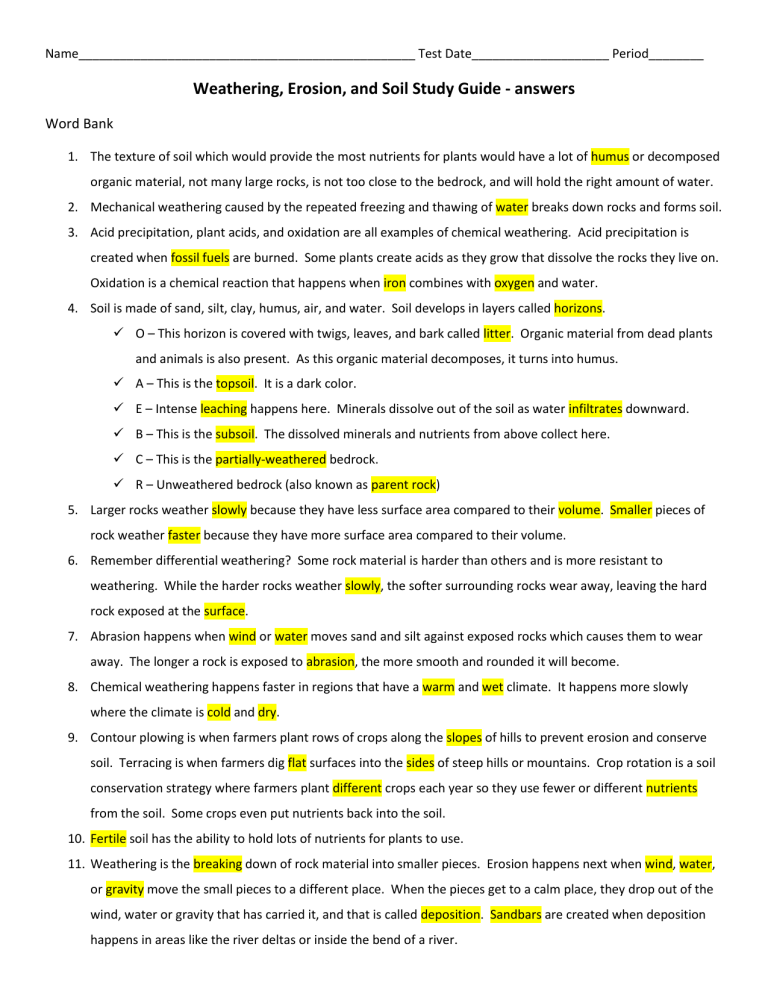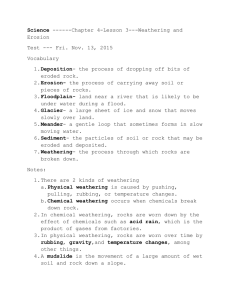Weathering, Erosion, and Soil Study Guide - answers

Name_________________________________________________ Test Date____________________ Period________
Weathering, Erosion, and Soil Study Guide - answers
Word Bank
1.
The texture of soil which would provide the most nutrients for plants would have a lot of humus or decomposed organic material, not many large rocks, is not too close to the bedrock, and will hold the right amount of water.
2.
Mechanical weathering caused by the repeated freezing and thawing of water breaks down rocks and forms soil.
3.
Acid precipitation, plant acids, and oxidation are all examples of chemical weathering. Acid precipitation is created when fossil fuels are burned. Some plants create acids as they grow that dissolve the rocks they live on.
Oxidation is a chemical reaction that happens when iron combines with oxygen and water.
4.
Soil is made of sand, silt, clay, humus, air, and water. Soil develops in layers called horizons.
O – This horizon is covered with twigs, leaves, and bark called litter. Organic material from dead plants and animals is also present. As this organic material decomposes, it turns into humus.
A – This is the topsoil. It is a dark color.
E – Intense leaching happens here. Minerals dissolve out of the soil as water infiltrates downward.
B – This is the subsoil. The dissolved minerals and nutrients from above collect here.
C – This is the partially-weathered bedrock.
R – Unweathered bedrock (also known as parent rock)
5.
Larger rocks weather slowly because they have less surface area compared to their volume. Smaller pieces of rock weather faster because they have more surface area compared to their volume.
6.
Remember differential weathering? Some rock material is harder than others and is more resistant to weathering. While the harder rocks weather slowly, the softer surrounding rocks wear away, leaving the hard rock exposed at the surface.
7.
Abrasion happens when wind or water moves sand and silt against exposed rocks which causes them to wear away. The longer a rock is exposed to abrasion, the more smooth and rounded it will become.
8.
Chemical weathering happens faster in regions that have a warm and wet climate. It happens more slowly where the climate is cold and dry.
9.
Contour plowing is when farmers plant rows of crops along the slopes of hills to prevent erosion and conserve soil. Terracing is when farmers dig flat surfaces into the sides of steep hills or mountains. Crop rotation is a soil conservation strategy where farmers plant different crops each year so they use fewer or different nutrients from the soil. Some crops even put nutrients back into the soil.
10.
Fertile soil has the ability to hold lots of nutrients for plants to use.
11.
Weathering is the breaking down of rock material into smaller pieces. Erosion happens next when wind, water, or gravity move the small pieces to a different place. When the pieces get to a calm place, they drop out of the wind, water or gravity that has carried it, and that is called deposition. Sandbars are created when deposition happens in areas like the river deltas or inside the bend of a river.
12.
Water is more dense than wind, so it is a more powerful agent of erosion, and it works faster in shaping the
Earth’s surface. Wind is a very weak agent of erosion, so change in the Earth’s surface happens slowly over a very long time. Deflation happens when wind removes fine sediment. When the small particles bounce and skip in the direction of the blowing wind that is called saltation. When sand is deposited, dunes form. They are mounds of sand that constantly shift as the wind continues to blow. Loess is a special kind of fine-grained glacial sediment that has been deposited by wind.
13.
Gravity also causes erosion. The angle of repose is the steepest angle rock material can hold on without sliding downhill. When the angle is too steep, mass movement happens. Landslides, mudflows, slumps, and creeps are all examples of mass movement. Mass movement of ice is called a glacier. Continental glaciers cover a very large area with very thick ice. They create a flattened landscape with small, round lakes called kettles. Valley glaciers build up in mountainous areas and carve out U-shaped valleys that rivers run through.











